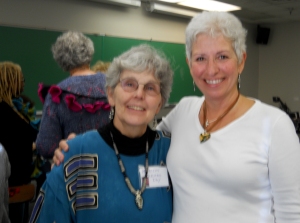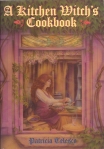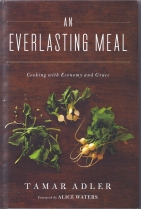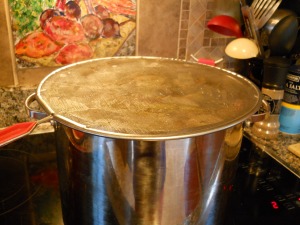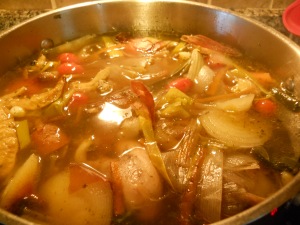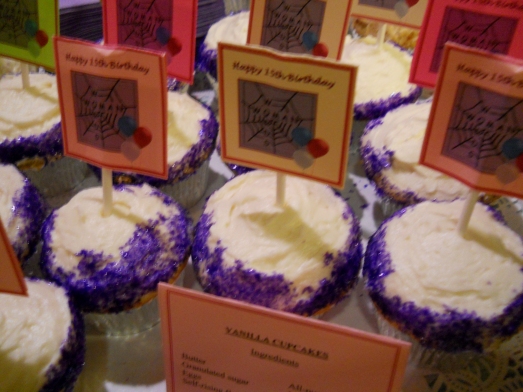FALL HARVEST FESTIVALS BEGIN – AND I DISCOVER A GREAT FOODIE CLUB AT ONE OF THEM!
 I know, I know – I was only taking the summer off from the computer (except for necessary e-mails, and I wasn’t very good about getting to them either), but it’s somehow already gotten to October. Well, I’m back but thought I’d readjust to the blogging thing with pictures from the Honest Weight Food Co-Op’s fall harvest festival (and this could be my only blog for at least for several days), which was held Sunday, September 23rd, and a couple snapshots from an event on Madison Avenue (also in Albany). It was at Honest Weight’s fest that I found a terrific resource, both local and online!
I know, I know – I was only taking the summer off from the computer (except for necessary e-mails, and I wasn’t very good about getting to them either), but it’s somehow already gotten to October. Well, I’m back but thought I’d readjust to the blogging thing with pictures from the Honest Weight Food Co-Op’s fall harvest festival (and this could be my only blog for at least for several days), which was held Sunday, September 23rd, and a couple snapshots from an event on Madison Avenue (also in Albany). It was at Honest Weight’s fest that I found a terrific resource, both local and online!
[NOTE that this blogpost was originally written about a week ago, drafted in MS Word, but when I attempted – several times – to complete it with pictures in the WP draft, big problems arose. Possibly with Gravatar, through which my photos get processed onto the blog, but perhaps ultimately with the fact that I have an old XP computer that WordPress doesn’t like any more because I can no longer download newer versions of my browser. Also, I can’t create links attached to words or phrases in the post, so I followed the phrases with the link, which is what I was doing before I knew how to streamline the process back when I first started the blog almost a year ago on 10/7/12. Looks like there’s a problem adding tags too. New computer needed but can’t afford it for a while. So I’ll “make do” with what I have, using the more time-consuming, roundabout way daughter Kristen figured out for me to add pics. She’ll be back to see if that can be improved upon!]
So, back to the festival… Apparently this was the “fourth annual” harvest event by Honest Weight. Who knew? I just happened upon an item in the Albany Times Union ten days beforehand and told Bill I wanted to try to get to Washington Park ( http://www.albany.com/hotspot_washington-park.cfm) on that day, where everything happens around the Lakehouse. Sunday surfaced nice and sunny, a perfect day for an outdoor festival. Especially one that promised “more than 45 local growers, chefs, artisans and other vendors, plus family fun, prizes, and samples from the Chefs Consortium.” It was free too. Of course, one needed $$ in order to purchase some of the great stuff available.
One of the fun things for me: nostalgia. Washington Park is situated just blocks from where I grew up, in the heart of the city of Albany, NY. It’s where I played when I was kid, with parents escorting my brothers and me when younger and then on our own as we grew older.

Zembo cousins (some of us), probably late 60s, very early 60s. Marilyn (me) in front; back are, l. to r., Mary, Jim, Lynn.
When we urbanites wanted some green background for pictures (once color photographs became more popular, or maybe just more affordable), it’s where we went with our Kodak cameras to pose for snapshots commemorating such things as First Holy Communion days and Confirmations.

First Communions all happened close to Tulip Festival Time, so I posed (looking quite holy) in front of one of the beds of tulips in the park.
The Lakehouse, opened in 1876 (for some Park history, (http://www.washingtonparkconservancy.org/Park_History.htm), still goes strong- with numerous events, spring through fall ,and then there’s winter ice skating and the Holiday Lights in the Park, a month-long drive-thru activity beginning at Thanksgiving time. The best of them (or at least the most well-advertised and attended): the annual Albany Tulip Festival in May, which has grown into a huge event since my kid-days, and musicals and plays presented free to the public all summer long.
We don’t get into Albany all that often, although there’s plenty to attract our attention, but each time we do find ourselves in the city, the where-did-the-time-go feelings start up. I love the architecture (check out the virtual tour at http://www.albany.com/tours/washington-park/index.html?KeepThis=true&TB_iframe=true&height=500&width=1000, where you can see some of the buildings surrounding the park!) and the knowledge that I’m “home” (yes, you can go home again; it’s just that lots of it’s in your mind while you wander around what’s left of where you lived – so many changes, not all of them good). Yet Bill, who also grew up in this Dutch-settled area, and I never fail to remark to each other that it wouldn’t be bad living in this city again—except it’s noisier than the suburbs and, inevitably, the issue of parking emerges.
So, mostly in pictures, here’s the fall food festival – with few comments provided. You’ll have to read further to find out what that newly-discovered foodie club’s all about. You might even want to join online!
*****
Once we found a parking spot along Madison Avenue, we walked around the edge of the lake to the starting point of the festival, where a hay and pumpkin set-up blocked the road off, marking Honest Weight’s temporary territory. (Yup, that’s me hold my bags – which are filled since the pic was actually snapped just before leaving.)

Two aisles to choose from, so we headed in the direction of the Lakehouse area first…
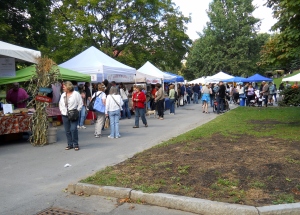
Which is where I found the FROM SCRATCH CLUB (FSC, at http://fromscratchclub.com/) table, in the tent outside the Lakehouse (enroute, stopping so Bill could get a cup of chili for lunch)….
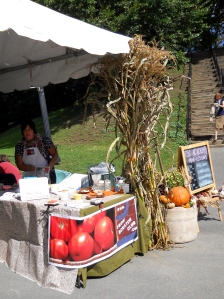
On their table, FSC had information about classes the group holds (dubbed “FSC Academy”), both in Ballston Spa and at the Arts Center of the Capital Region in Troy. They also hold “food swaps” of homemade items in various parts of the Capital District/Saratoga area.

 I noticed a book I love atop some papers, An Everlasting Meal by Tamar Adler (I wrote about its influence on me in a 5/25/12 blogpost titled “How to Get Rave Reviews: Start with Homemade Chicken [or Other] Stock” at https://kitchencauldron.wordpress.com/2012/05/26/how-to-get-rave-reviews-start-with-homemade-chicken-or-other-stock/). I commented to one of the women behind the table on how much I enjoyed that book, and she told me about FSC’s book club online at GoodReads (http://www.goodreads.com -you can join too- just look for book clubs). I took some flyers about the group. Adler’s book was their first read and they were about to start on The Homemade Pantry: 101 Foods You Can Stop Buying & Start Making by Alana Chernila (Crown Publishing Group, Random House, 2012). I already owned this one too and had read it this past spring. I decided I was going to check this out!
I noticed a book I love atop some papers, An Everlasting Meal by Tamar Adler (I wrote about its influence on me in a 5/25/12 blogpost titled “How to Get Rave Reviews: Start with Homemade Chicken [or Other] Stock” at https://kitchencauldron.wordpress.com/2012/05/26/how-to-get-rave-reviews-start-with-homemade-chicken-or-other-stock/). I commented to one of the women behind the table on how much I enjoyed that book, and she told me about FSC’s book club online at GoodReads (http://www.goodreads.com -you can join too- just look for book clubs). I took some flyers about the group. Adler’s book was their first read and they were about to start on The Homemade Pantry: 101 Foods You Can Stop Buying & Start Making by Alana Chernila (Crown Publishing Group, Random House, 2012). I already owned this one too and had read it this past spring. I decided I was going to check this out!

Hubby and I then wandered back the way we’d come, perusing fresh vegetables and homemade items on the opposite side of the aisle. At one booth, we bought two scones (which we devoured a couple days later) and two cinnamon-apple buns (Bill ate one right away; our son Adrian happily consumed the other the next day). Up the other lane of tents, angled around the hill in front of the Lakehouse, I found a stand of yummy-looking baked goods, from which I selected four huge cookies, two cranberry-chocolate chip plus two choc-chips with potato chips and pretzels. I managed to munch on one while walking around and the rest came home with us.

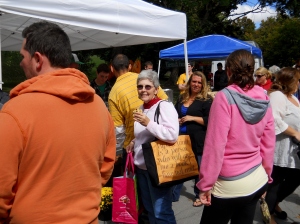
One of my favorite vendors from the Schenectady Green Market, The Pasta Factory, had taken the day off from that Electric City gig to participate in Honest Weight’s extravaganza. I bought ¾ pound of a multi-colored orzo that contains a note indicating there’s a bit of jalapeno in it (Bill & Ade will love that!), as well as ¾ pound of a mixture of various shapes and colors whose ingredients list included things like sweet potato and lime. The latter mix became an Italian-style casserole Tuesday might, created with good cheeses, sauce from scratch, and ground Italian sweet sausage – which went over BIG with the guys. (No, that recipe isn’t going to appear on this blog because I didn’t take any pictures!) That “sauce from scratch,” incidentally, included a dozen very orange, heirloom, plum tomatoes that called to me from another festival table, popping up from perches in a recycled egg carton!
We wandered around for at least an hour-and-a-half, loving the sights, sounds, aromas and weather.


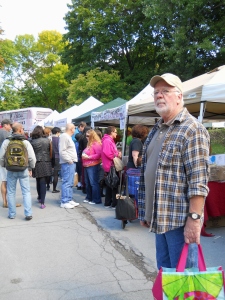
No visit to Washington Park, at least not in the Lakehouse area, is complete for me without a visit to Moses (http://alloveralbany.com/archive/2011/04/18/the-moses-fountain-in-washington-park) . The monument, that is. Moses has been around the park since his unveiling in 1893. We played around Moses (and on Moses, when we could get away with it – a different definition, when I think of it, for “on the rocks”) as kids, occasionally coming away with scrapes and cuts. The garden area encircling him is awesome. I especially love the blooms during our short tulip season in May – absolutely gorgeous. During this visit I even spoke with a woman who said she had also climbed the monument when she was a kid, although I think she said she lived on the other side of the park from where we resided. She’d recently returned from out-of-state to once again live in the area.






After a few minutes of rest on a park bench, we headed back toward the car, past the festive tents.


You’d think we’d had enough but we decided to stop by the Madison Avenue event, which was more like a block party than a harvest fest. I bought a great chocolate Halloween witch, etched in tinted chocolate atop a totally chocolate casket, which opened to reveal mini-chocolate pumpkins, skulls (white choc), and a black (dark choc) cat. All innards melted in my mouth within a day or so, and – with a little help from Adrian- you might say we terminated the casket. I also came away with a preserve from a woman who said she’s used it as a rub on pork, to the raves of dinner guests.
Best part of this stop, however, was that we ran into several friends, including Therese and hubby Frank, and another poet/writer friend (another Frank), and Anne Marie and Ed . Anne Marie’s White Pine Studio (http://www.etsy.com/shop/whitepinestudioamf) tent was pitched and selling. I brought home a pair of her handmade earrings and some of her notecards (had to get them—she’d painted the Snake Goddess picture years ago, at a time when we were on personal retreats at the same time at Still Point!).

Bill chatted with Ed for a while. Ed and I shared an office years ago, back when we both worked for NYS Division of Parole – on the very same block of Madison Avenue where this fest was happening! I think he even mentioned something about being back in his old neighborhood again as well… ah, nostalgia again (and his mom was with them too!).

I think Ed & Anne Marie might be posing right in front of the building (since remodeled) where Ed & I shared an office back in the mid-’90s. If it not, then it’s the place next-door.
We arrived home having loved the day and expecting to further enjoy it via our purchases. No fresh fruits and very few veggies were toted back to the homestead this time (the cupboard was far from bare in this department!), but we’re still lovin’ our purchased goodies. Plus, I joined GoodReads almost immediately, signed up for the FSC Book Club and have partially completed my first assignment from The Homemade Pantry. I made the Ricotta Cheese in Chapter 1 (Who’da thought I’d ever do that?!). Took pictures and will be posting them, blogging about it too. Maybe I’ll even go for Chapter 2’s Homemade Toaster Pastries. even though we were only “assigned” (no pressure to actually do it) to create one homemade goodie from either of the first two chapters. Back in the day, I was always one of those nerds who’d go for the “extra-credit” assignment – although only for English or art class!
 Most pasta – no matter what kind or how prepared – qualifies as comfort food for me. The old standard Macaroni and Cheese ranks #1 in my book, probably because it was a my mother’s dish my mother often served. She tossed together canned, diced tomatoes and American processed cheese – plus elbow macaroni and whole milk (no one even hear of 1% or 2% milk back then, and skim was too skimpy). That’s about it, except for salt, pepper and maybe a little garlic salt if she had it. It was always delicious. I make a sort-of version of hers about once a month, although with different (and alternating) cheeses, but I often hunger for something a little different.
Most pasta – no matter what kind or how prepared – qualifies as comfort food for me. The old standard Macaroni and Cheese ranks #1 in my book, probably because it was a my mother’s dish my mother often served. She tossed together canned, diced tomatoes and American processed cheese – plus elbow macaroni and whole milk (no one even hear of 1% or 2% milk back then, and skim was too skimpy). That’s about it, except for salt, pepper and maybe a little garlic salt if she had it. It was always delicious. I make a sort-of version of hers about once a month, although with different (and alternating) cheeses, but I often hunger for something a little different. Seems natural that I’d look for an easy-to-prep pasta dish for some of the homemade ricotta I’d made (see previous blogpost, dated October 4, 2012). I checked out a fav cookbook that’s been on my shelf for years, The Best 125 Meatless Pasta Dishes by Minday Toomay and Susann Geiskopf-Hadler (Prima Publishing, 1992), and found Ricotta with Nutmeg and Peas. Nutmeg being a favorite spice of mine, plus knowing it goes great with cheese of almost any kind, it was no contest about this selection.
Seems natural that I’d look for an easy-to-prep pasta dish for some of the homemade ricotta I’d made (see previous blogpost, dated October 4, 2012). I checked out a fav cookbook that’s been on my shelf for years, The Best 125 Meatless Pasta Dishes by Minday Toomay and Susann Geiskopf-Hadler (Prima Publishing, 1992), and found Ricotta with Nutmeg and Peas. Nutmeg being a favorite spice of mine, plus knowing it goes great with cheese of almost any kind, it was no contest about this selection.

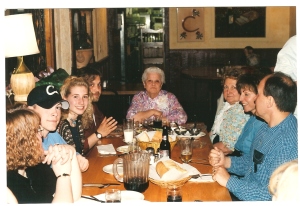
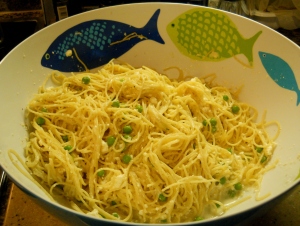




































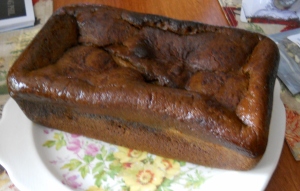




 the workshop, the potful I wound up freezing to bring to Still Point also was thick and rich, with an added herb (marjoram) and some pre-cooked chicken that were not ingredients in the first round! Packing the large cooler for my weekend (I had opted to bring my own food for the extra days I’d registered to stay in my little cabin), I also included a small container of homemade chicken stock to add to the soup while it simmered during the morning portion of our daylong session. I planned to use SP’s slowcooker for warm-up. Unfortunately the ceramic portion of that appliance was partially cracked, which meant “not such a good idea.” The alternative, using the stovetop, almost resulted in burning the soup as it simmered while we participated in storytelling in the other room in Welcoming House. It was sticking to the pan when I finally got out to the kitchen to stir again! Adding a bit more liquid helped, although it thinned the soup out.
the workshop, the potful I wound up freezing to bring to Still Point also was thick and rich, with an added herb (marjoram) and some pre-cooked chicken that were not ingredients in the first round! Packing the large cooler for my weekend (I had opted to bring my own food for the extra days I’d registered to stay in my little cabin), I also included a small container of homemade chicken stock to add to the soup while it simmered during the morning portion of our daylong session. I planned to use SP’s slowcooker for warm-up. Unfortunately the ceramic portion of that appliance was partially cracked, which meant “not such a good idea.” The alternative, using the stovetop, almost resulted in burning the soup as it simmered while we participated in storytelling in the other room in Welcoming House. It was sticking to the pan when I finally got out to the kitchen to stir again! Adding a bit more liquid helped, although it thinned the soup out.



